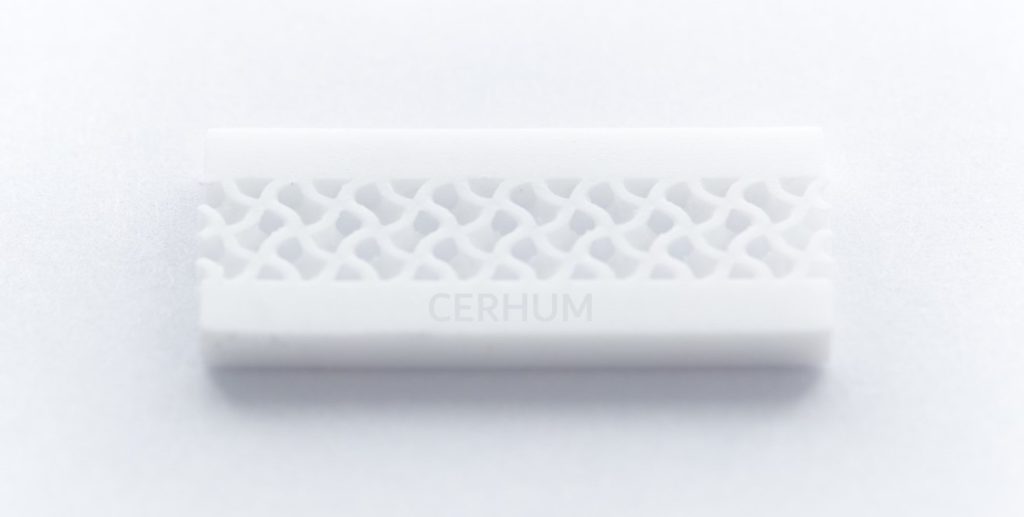Based in Leige, Belgium, Cerhum is now offering its hydroxyapatite 3D printed bone product to surgeons in order to treat facial deformations. These MyBone products are 3D printed by Cerhum under ISO 13485 and Medical Device Regulation 2017/745 (MDR), and registered with the Belgium Competent Authority (FAMHP, registration number BE/CA01/1-72228). This means that this is no lab project or an exciting possible future application but something that surgeons can use today. MyBone is the first approved 3D printed bone graft that is commercially available. Targeted at maxillofacial and orthopaedic surgeons, MyBone implants can also be made patient-specific.
Typically facial reconstruction surgery relies on autografts, whereby a part of a patient’s ribcage is extracted and implanted elsewhere. These operations are cumbersome, involve more procedures, and can take a great deal of time to treat a patient. Cerhum, a spinout of Belgian research organization Sirris, has achieved an impressive world first here. 3D printed bone made out of hydroxyapatite, which is very similar to our natural bone, will be a boon to patients and surgeons alike.
Before the product reached commercial availability, MyBone was part of a controlled release phase, which included one particularly complex surgical case. Through the use of MyBone, the medical team was able to perform facial reconstruction with a 3D printed implant that looked “exactly like natural bone on a recent CT scan.” Dr Christophe Ronsmans, Head of Department Plastic surgery, CHR Liege, said about the patient, “Given the complexity of the defect, it would have been impossible to achieve such perfection from an aesthetic point of view and such a functional result with current methods.”
“We are very proud to have successfully gathered vital clinical data and passed all the regulatory hurdles with a synthetic bone graft that is safe and effective. Our 3D printed bone implants offer a unique, patented porous structure that allows ingrowth of blood vessels. This process, called vascularisation is key to achieve successful bone ingrowth. As a result, MyBone has shown 7x faster bone ingrowth than currently available bone graft granules. Due to extremely positive feedback of maxillofacial surgeons so far, Cerhum is expanding its portfolio into the dental and oncological market,” said Cerhum Founder Grégory Nolens.

In 3D printing, orthopedic implants made from cobalt chrome and titanium have been the norm. Now, we are seeing a lot of firms get clearances for titanium implants from toes, to feet, knees, fingers and skulls. What is perhaps not realized sufficiently is that Cerhum and companies like it could very well disrupt a lot of the existing metal implants with material that is more similar to our natural bone.
Cerhum claims that its implants limit pain, and speed up rehabilitation and healing. The company also has a unique control over porosity, which could see them make hydroxyapatite 3D printed bone structures with different properties, depending on what is needed where. Cerhum has reportedly printed tens of thousands of bone grafts for orthopedic implants, as well.

Hydroxyapatite is already the main constituent of bone and, so far, it has been problematic to make hydroxyapatite implants sufficiently strong to work well. If the company can continue to prove that its bone autografts perform adequately, Cerhum could perhaps expand into trauma, oncology, and other areas where plastic surgery is needed.
We can’t tell if the firm’s technology could replace knees or other parts of the body, but even if it could not, the scope could be enormous. Allografts, in which tissue from a donor is used, are performed 1.5 million times a year in orthopedics. Cerhum is a very exciting startup that could really revolutionize how bone grafts work in patients, expanding the efficacy and use of 3D printing further into medicine.
Subscribe to Our Email Newsletter
Stay up-to-date on all the latest news from the 3D printing industry and receive information and offers from third party vendors.
Print Services
Upload your 3D Models and get them printed quickly and efficiently.
You May Also Like
Heating Up: 3D Systems’ Scott Green Discusses 3D Printing’s Potential in the Data Center Industry
The relentless rise of NVIDIA, the steadily increasing pledges of major private and public investments in national infrastructure projects around the world, and the general cultural obsession with AI have...
Formlabs Teams Up with DMG MORI in Japan
In late June, Nick Graham, Chief Revenue Officer at Formlabs, announced on LinkedIn that the company had partnered with DMG MORI, one of the world’s leading machine tool companies, to...
EOS in India: AM’s Rising Star
EOS is doubling down on India. With a growing base of aerospace startups, new government policies, and a massive engineering workforce, India is quickly becoming one of the most important...
3D Printing News Briefs, June 25, 2025: R&D Materials, 3D Printed Veneers, & More
In today’s 3D Printing News Briefs, 3DXTECH has launched a program that gives customers early access to experimental materials, and the first Lithoz CeraFab Multi 2M30 in the Czech Republic...



































